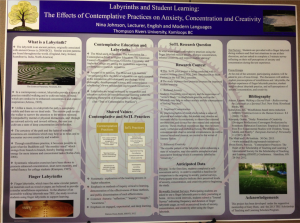I’ve been reading everything I find about mindfulness, but I’m eager for more evidence-based work on its effects on learning in the college classroom. As my previous posts indicate, recent years have seen a lot of scientific research (especially in neuroscience and psychology) pointing to the psychological and physiological effects of mindfulness. There’s also plenty of exploration in K-12 education, often for issues related to classroom behavior and management, but what about our students, and what about the effect on learning itself?
The progress isn’t as slow as I’d initially thought. I appreciated the March and May 2012 issues of National Teaching & Learning Forum with the cover stories on contemplative pedagogy, as well as summer 2013 issue of New Directions for Teaching and Learning on “Contemplative Studies in Higher Education.” The Center for Contemplative Mind in Society has also started a peer-reviewed, scholarly journal, The Journal of Contemplative Inquiry, and I look forward to their first issue. There are also some fabulous books out there, from Ellen Langer’s now classic The Power of Mindful Learning (1998) to Parker Palmer and Arthur Zajonc’s The Heart of Higher Education (2010), which is much broader but includes mindfulness.* These sources are particularly interesting because they reach beyond the initial notion of meditation in the classroom to broader learning issues that are affected by a variety of mindful practices.
I’m particularly excited about some research in progress I heard about at two recent conferences. Two posters and a presentation I saw focused squarely on mindfulness and learning, and I’ll write about each of them over the next few weeks. First, the most recent.
A few weeks ago, I was in Banff, Alberta, Canada, for the 2013 Symposium on Scholarship of Teaching and Learning,** and I was thrilled to come across the poster presentation by Nina Johnson from Thompson Rivers University (Kamloops, BC). She’s conducting a scholarship of teaching and learning (SoTL) project in which she investigates her own students’ learning–in this case, focusing on the effects of a specific mindful practice in her creative writing course. Her students are using finger labyrinths before they write in their journals*** and take their exams. She’s interested the potential applications of three documented effects of mindfulness on her students’ short fiction writing:

Nina Johnson's Poster, Labyrinths and Student Learning: The Effects of Contemplative Practices on Anxiety, Concentration, and Creativity
- reducing anxiety to help prevent or manage writer’s block,
- improved concentration to help students notice what’s going on around them and within themselves more precisely, which “may then be more easily verbalized and crafted as fiction,” and
- harnessing the relaxation of the practice to “enable metaphorical and associative thinking which is commonly labelled as ‘creativity.‘”
After the class is over in December, she’ll be looking at a variety of direct and indirect evidence of the students’ learning experiences: the students’ journals and short stories, as well as a variety of surveys and focus group conversations with the students. Students will also be tracking their experiences and their perceptions of the effects of the practice. I look forward to what they find, and as soon as the study is made public, I’ll share it here as well.
Practice
- First, get a labyrinth:
- Download and print this labyrinth, or
- just open this labyrinth on your screen, and you’ll use your mouse or trackpad,
- or buy this app, if you have an iPhone or iPad ($1.99 in iTunes).
- Take a few slow breaths, and focus your attention on your labyrinth. In the same way that you’ve kept your attention gently focused on your breath in previous practices, you’ll now use the labyrinth as your anchor.
- Using your finger (if it’s a printout or the app) or your mouse/cursor (if it’s on your screen), ideally with your non-dominant hand, slowly trace the circuit from the outside path toward the center.
- As thoughts or feelings arise, simply notice them, and then bring your attention back to your circuit.
- Once you’re in the center, pause, breathe, and then start your way back out–slowly.
- Repeat as many times as you like, whenever you like.
What was this experience like for you?
—
* Last year, the Vanderbilt Contemplative Pedagogy group selected the Palmer and Zajonc book as our summer reading. It led to a great discussion!
** I wrote about my overall experience in another blog–with pictures.
*** These journals aren’t journals in the sense of a diary; they’re creative writing journals for students to begin imagining and drafting their short stories.
—




